Tips for a Fall Camping Trip
The weather has turned crisp or even cold, the kids are back in school, and the summer tourist season is over. Believe it or not, now is the best time to go camping!
Fall camping offers many rewards, including less-crowded campgrounds, increased wildlife spotting, and outdoor recreation pursuits best experienced in the cooler months.
Here’s what you need to know before camping outside this fall.
Fall Camping Activities
Your favorite lake or river may no longer be ideal for swimming in the fall, but many outdoor activities are still available.
Fall foliage viewing: Although it’s only possible during a very small window of time each autumn,
fall foliage viewing (also known as leaf-peeping) is a popular tourist season in parts of the Midwest, Mid-Atlantic, and New England.
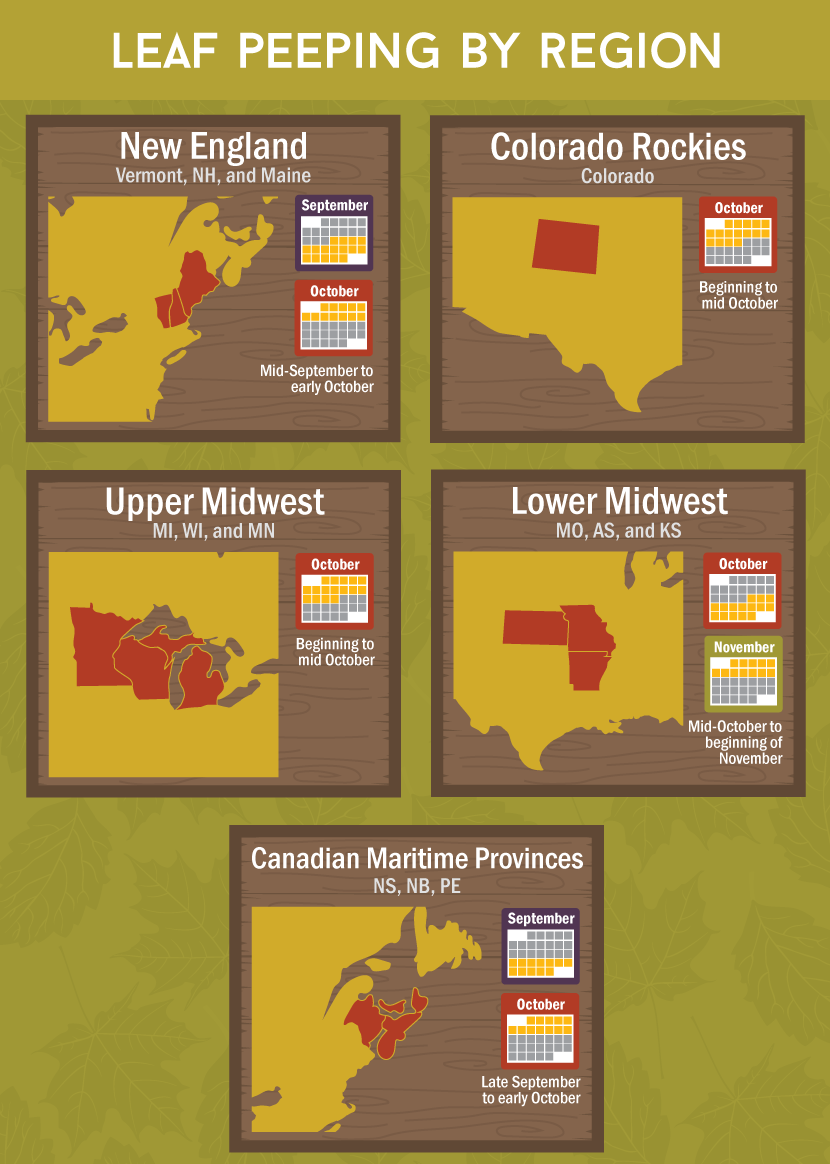
Fall fishing: Continue to fish in the fall! The best time to fish during this time of year is in late afternoon and early evening as the fish come to the surface to feed on insects that enjoy the sunshine.
Unlike in summer, mornings are generally too cool in the fall. Early autumn is known for salmon runs and pike fishing in much of the United States.
Hunting: Hunting may be the most well-known, most popular fall outdoor activity in many regions. Fall is the time for deer and elk seasons and for fowl hunting.
If you’re not a hunter, it’s important to be aware of this activity and whether it’s permitted in the forests you’re frequenting. It’s safest to stay on trails and in campgrounds because hunters generally hike across the terrain.
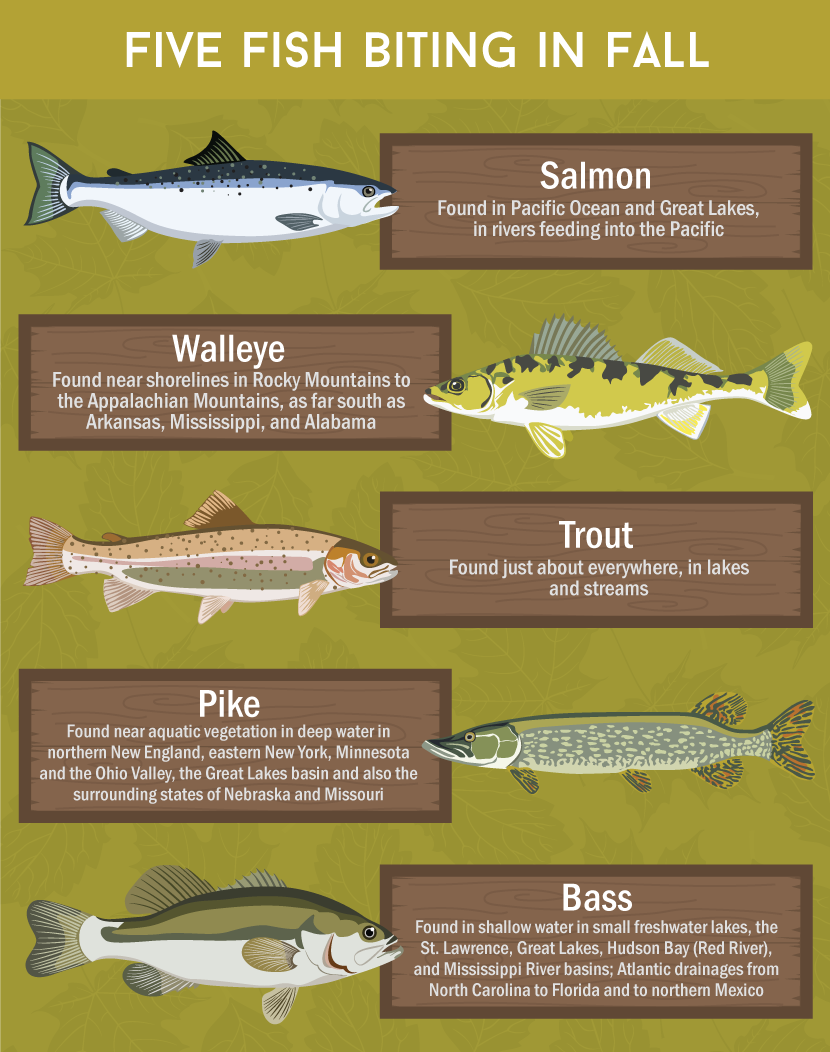
Berry foraging: Berries ranging from blackberries, blueberries, and raspberries can be found throughout the United States and Canada on low bushes native to our most hostile climate: the snow country of the U.S./Canadian borderlands.
This is a great time to be in the mountains and foothills before the snow flies. Pick berries on public land or patronize a ‘U-Pick’ berry location near your campground.
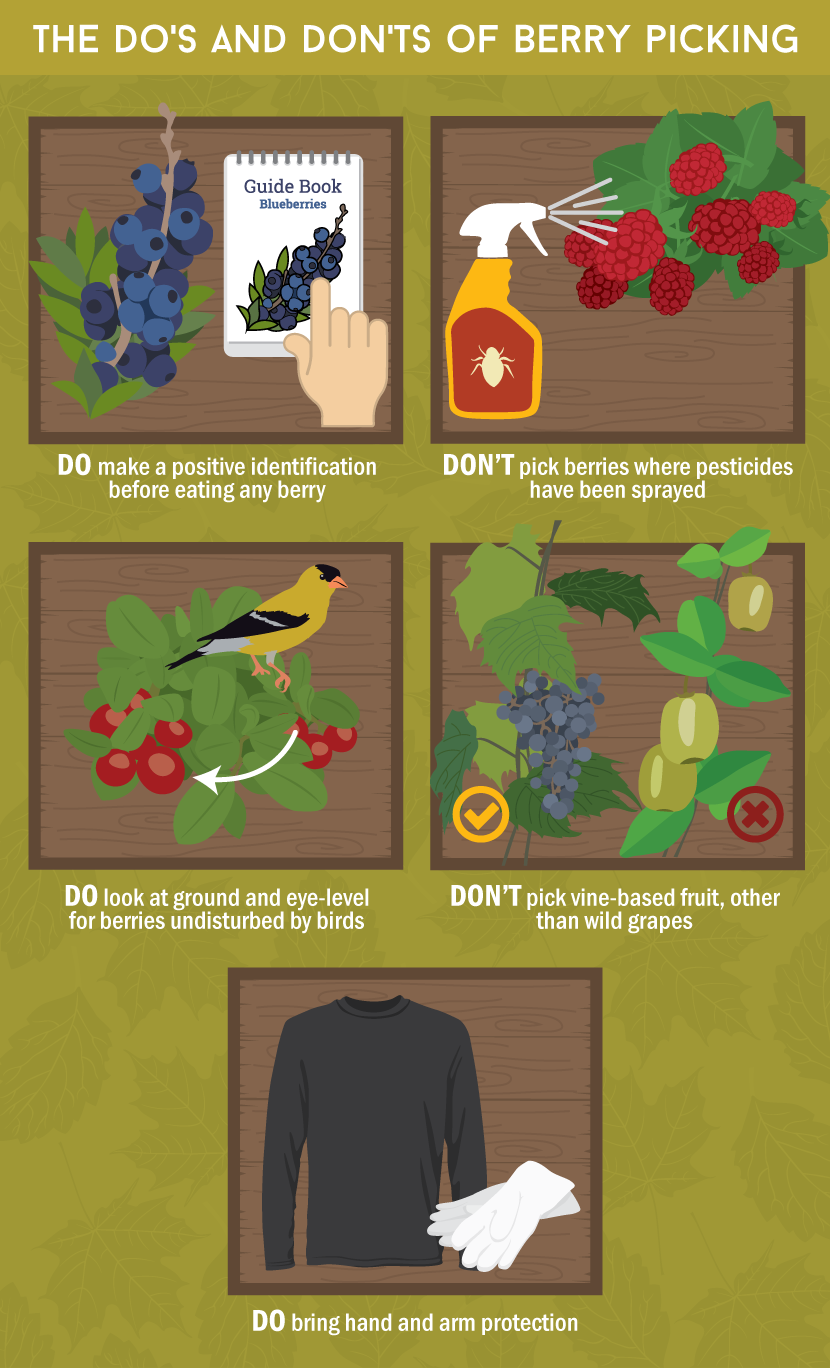
Staying Warm and Dry
One challenge of fall camping, of course, is staying warm. Fall weather can be all over the map, which means layering and multiple clothing options are essential as are using the right tents and shelters.
With the right protection, weather-related complications, such as hypothermia or frostbite, can be avoided.
Wear wool base layers: Wool fibers wick away moisture from the skin, keeping campers dry and warm. It also dries relatively fast. Have a wool base-layer shirt and pants at the ready during fall camping trips to warm up in the evenings and mornings.
Keep your core warm: Consider a lightweight vest or extra layer on the top half of your body to maintain a comfortable core temperature.
Stay dry: Pack rain wear (rain pants and a rain jacket) and set up rain flies on tents in the fall. Staying dry is the easiest way to stay warm as the weather cools.
Don’t forget about your head, hands, and feet: As the body works to maintain a healthy temperature, blood is diverted first from the hands and feet to keep the core warm.
Don’t forget to keep your feet dry with waterproof shoes or boots and wool socks, and use lightweight gloves in chilly weather.
Heat escapes easily from the head, so wear a knit hat during cold evenings.
Use down, DownTek, or down-alternative sleeping bags, blankets, and jackets: Down (or a down alternative) is a natural insulator that won’t weigh you down.
A great material used in lightweight jackets, sleeping bags, and blankets, DownTek is a newer blend that dries faster than traditional down if you encounter rain.
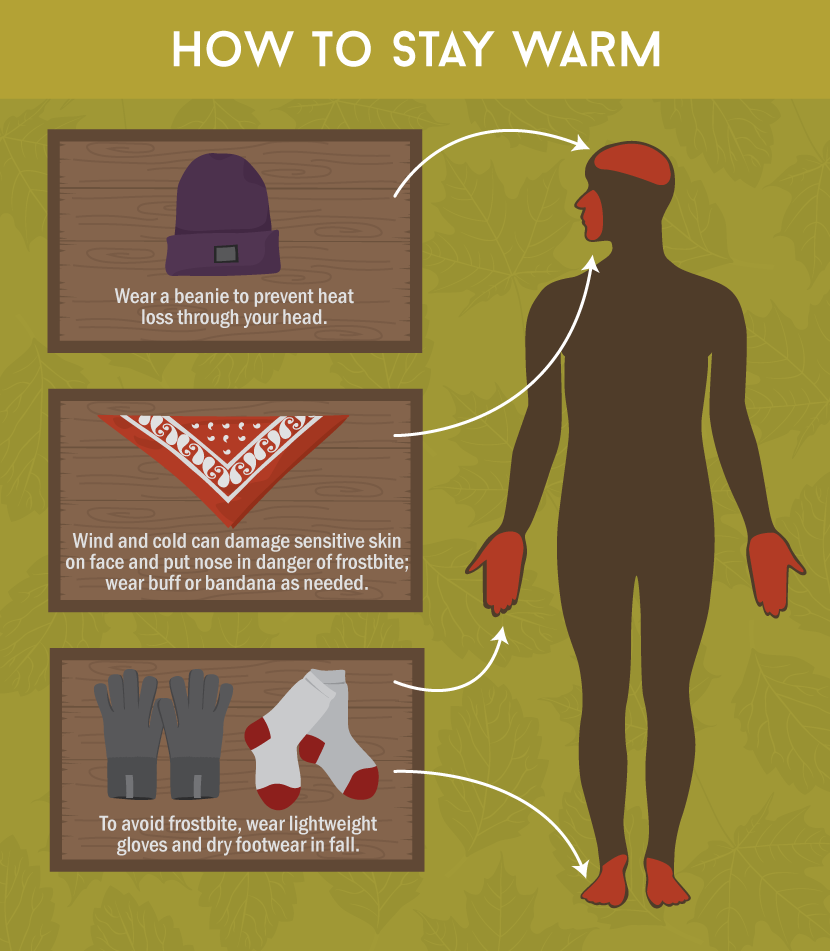
Fall Camping Meals
There’s nothing quite like cozying up to an autumn fire with a bowl of chili or stew. Cooking slow-roasted or slow-cooked meals over the fire is possible using a Dutch oven, camping stove, and/or foil packets. Try one of these easy fall camping meals.
Chili: This is an inexpensive yet filling camping meal. Mix your favorite beans and meat with a can of diced tomatoes, peppers, and onions, and season it with chili powder and cumin. Serve with camp cornbread or tortilla chips.
Beef or chicken stew: Your favorite stew recipe can almost always be recreated in the outdoors. Use a Dutch oven to allow your stew to simmer longer.
Berry cobbler: Pick your own berries or buy a bag of frozen berries. Mix them with sugar and cinnamon, and top it with store-bought crust dough. Cook your cobbler in a Dutch oven or even over a campfire on a grill.
Baked potatoes: Wrap potatoes in foil, then place them in the coals of a fire. Unwrap and enjoy. Need a heating pad more than you need nourishment? Let the potatoes cool slightly and place them in sleeping bags for cozy heat at night.
Biscuits: Using store-bought dough, biscuits can be made on a stovetop, in a Dutch oven, or even over the fire by wrapping refrigerated dough around a stick for roasting.
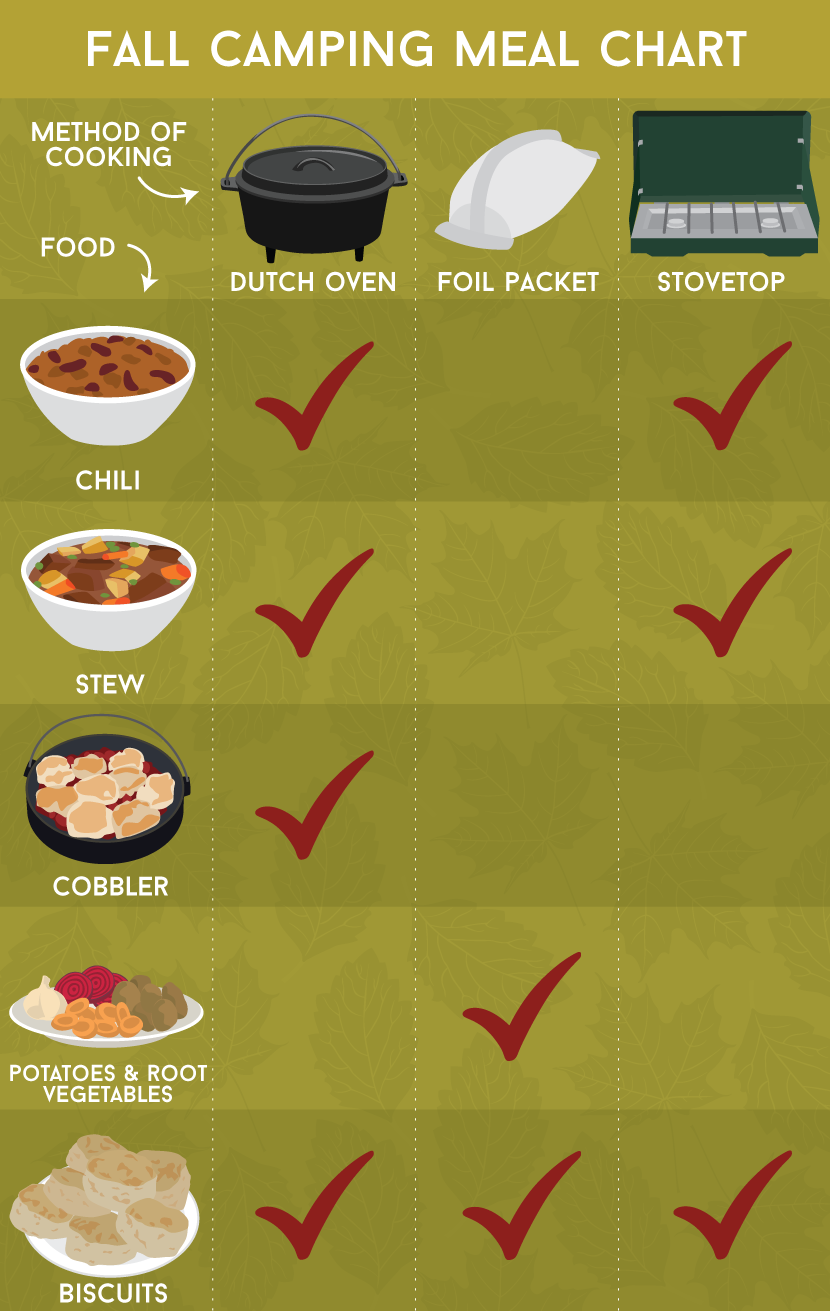
“Snowbird” Camping
Want all the benefits of fall camping, such as fewer crowds and peaceful campgrounds, without the cold weather?
Head south for a fall camping trip or opt for an alterative camping venue, such as camping cabins, yurts, or teepees, which offer more shelter and protection.
Moab, Utah: Stay in campgrounds in a nearby national park, such as Arches National Park or Canyonlands National Park.
Sedona, AZ: Camp outside Sedona at Slide Rock State Park and enjoy natural waterslides without the summer crowds.
Florida Everglades: Multiple camping options are available in Everglades National Park.
Georgia state parks: Georgia state parks are known for their beauty and peacefulness, especially in the off-season.
Death Valley, CA: Too warm to enjoy in the summer, Death Valley National Park shines in the fall and winter, offering hiking canyon trails and golfing.
Embed the article on your site

